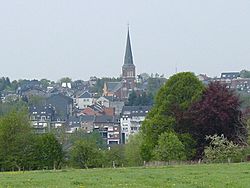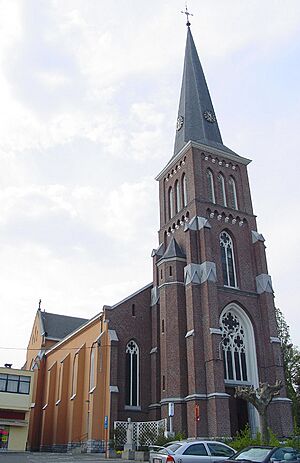Kelmis facts for kids
Quick facts for kids
Kelmis
|
|||
|---|---|---|---|

View of Kelmis
|
|||
|
|||
| Country | Belgium | ||
| Community | German-speaking Community | ||
| Region | Wallonia | ||
| Province | Liège | ||
| Arrondissement | Verviers | ||
| Area | |||
| • Total | 18.12 km2 (7.00 sq mi) | ||
| Population
(2018-01-01)Lua error in Module:Wd at line 1575: attempt to index field 'wikibase' (a nil value).
|
|||
| • Total | Lua error in Module:Wd at line 1,575: attempt to index field 'wikibase' (a nil value). | ||
| Postal codes |
4720–4728
|
||
| Area codes | 087 | ||
| Website | www.kelmis.be | ||
Kelmis is a town in Belgium. It is located in the province of Liège. The town is named after "calamine," which is a type of zinc ore. This mineral was found in large amounts nearby.
As of 2011, about 10,881 people lived in Kelmis. The town covers an area of 18.1 square kilometers. This means it has a population density of about 601 people per square kilometer. Kelmis includes three main parts: Kelmis itself, Hergenrath, and Neu-Moresnet.
Contents
A Unique Past: Neutral Moresnet
For over 100 years, the area around Kelmis had a very special status. From 1816 to 1919, it was known as Neutral Moresnet. This was a "neutral condominium." A condominium is a territory ruled by two or more countries together.
Neutral Moresnet was shared by the Netherlands and Prussia (which later became part of Germany). After Belgium became independent, it took over the Netherlands' role. The mayor of Kelmis was chosen by officials from both countries.
People living there tried to make Neutral Moresnet a fully independent small country. However, these attempts did not succeed. The area stayed neutral and under shared rule. After the First World War, Belgium officially took control of Neutral Moresnet in 1919.
Remembering History
Kelmis has memorials that help people remember its past.
- One memorial is on Aachener Strasse. It honors German soldiers from Kelmis who died during the Franco-Prussian War.
- Another memorial is in Kirchplatz (Church Square). This one remembers people from Kelmis who died in the First and Second World Wars.
Language and Culture
In the 1800s, people in Kelmis spoke a dialect called Low Dietsch. Today, Kelmis is mainly a German-speaking town. It is one of the nine municipalities in the German‑speaking Community of Belgium.
Even though German is the main language, Kelmis also has services for French speakers. This helps everyone in the community.
Museum Vieille Montagne
There is a small museum in Kelmis called the Museum Vieille Montagne. This museum tells the story of the area. It has exhibits about the history of Neutral Moresnet. You can learn about how the zinc mine influenced the region.
More than 50 of the original 60 border markers for Neutral Moresnet are still standing today. These markers show the old boundaries of this unique historical territory.
See also
 In Spanish: Kelmis para niños
In Spanish: Kelmis para niños





